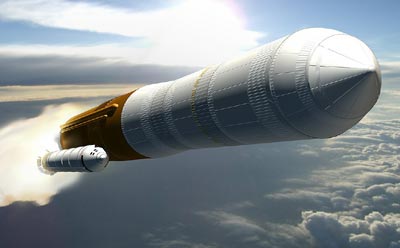How to become a presidential heroby Greg Zsidisin
|
| Taking a vocal stance on NASA and exploration that is visionary yet fiscally responsible might play very well to a populace weary of issues that deal only with negatives, such as war and the economy. |
As with some other key sessions at ISDC this year, audience members were not given the opportunity to ask questions. That’s really too bad, because I’m sure audience members would have injected a lot more life and spirited debate into the proceedings. As it was, we got what amounted to exhortations by NASA to support the Vision for Space Exploration (VSE) and ISS programs exactly as they are.
Coming away from these sessions, as well as Stephen Metschan’s talk on DIRECT in a much smaller afternoon breakout talk, I’ve begun to think that a presidential candidate could make a real splash if he or she cast themselves as a reformer of NASA.
To wit: taking a vocal stance on NASA and exploration that is visionary yet fiscally responsible might play very well to a populace weary of issues that deal only with negatives, such as war and the economy. We really need a hero these days, and spaceflight is one of those few areas Americans can point to with ready, justifiable pride. At the same time, this is hardly the point at which a battle cry of “Mars or bust, damn the cost!” can be made.
This is not about the merits or demerits of the specific shuttle-derived vehicles that the DIRECT team advocates. Overall, they make several excellent general points. If we’re truly trying to build a robust family of launch vehicles that will take us into the next 30 or 40 years of spaceflight, to pursue whatever specific goals we choose—and do that basically within the constraints of NASA’s current budget—the Ares 1/5 route doesn’t make much sense.
A far more reasonable approach would leave the vast majority of our unique launch facilities, experience, and workforce in place. The overriding principle would be to use whatever immediate technology we have at hand, and rigorously keep new development work and “requirements creep” at a minimum.
This approach would also assiduously avoid duplication of existing capabilities, especially those available or nearly available commercially. (A particular question: why develop Ares 1 when EELVs can do the job if they’re human-rated? And why not create an incentive for Boeing and Lockheed Martin to do it on their dime, in exchange for flight guarantees?) Because of this, NASA is absorbed in the creation of Ares 1, when it could well focus on getting its Orion Crew Exploration Vehicle (CEV) built and tested, as well as the J-2X engine that is probably required for any new large launcher family. (For now, we’ll leave off why development of a variant of the in-production RS-68 engine wouldn’t be a wiser, nearer-term choice in the upper stages on at least some missions.)
The point is that there is no shortage of opinion that NASA’s approach is confoundingly complex and inefficient. That perception is undiminished by the marked absence of real persuasion on NASA’s part that it is set on the right course.
Enter the presidential hero. A candidate or new president-elect could score some quick political points not only by making an eloquent case for returning to exploration, and keeping America the leader in something it does best, but taking NASA to task on its VSE implementation, and setting it straight.
That last point doesn’t have to be a negative, either. A newly-inaugurated President Clinton, McCain, or Obama could give NASA a big public challenge to do better, while instructing the agency to do no damage or modification to the nation’s precious STS infrastructure. Let him or her challenge NASA to come up with a better plan to get its new launcher online sooner, and cheaper.
| A candidate or new president-elect could score some quick political points not only by making an eloquent case for returning to exploration, and keeping America the leader in something it does best, but taking NASA to task on its VSE implementation, and setting it straight. |
Frankly, if the immediate concern is about getting Orion spacecraft to the ISS, I think we could find a way to human-rate EELVs to carry those, even if it meant creating a first-pass CEV with reduced capability, with room for growth into the full-fledged CEV intended for flight beyond the ISS. At least we’d have American vehicles flying a new American spacecraft, something certainly doable within a single presidential term.
Let the president also challenge NASA to come up with a more reasonable plan to transition from that to launch vehicles with more capability than EELV by adapting the shuttle infrastructure in a more direct way, whether it looks very much like DIRECT or something else. When that’s ready, we can move the CEV back to flying from Launch Complexes 39A and B, and begin to work on a truly capable exploration program using a more sensible adaptation of the STS infrastructure and workforce.
In this way, the president would be a true hero. He or she would make an early, positive example of real leadership by keeping our commitment to a return to exploration and to the International Space Station, while making NASA more accountable to fiscal reality and public expectation. All over the tiny (albeit inordinately visible) portion of the federal budget involved.
What could be more of a slam dunk for a new president?
